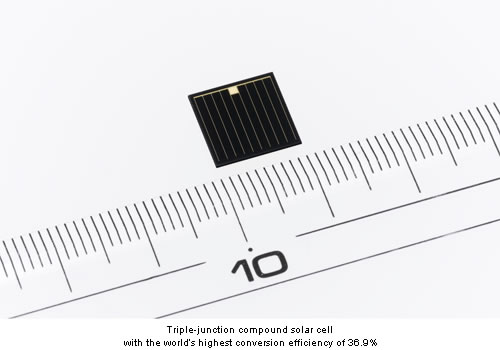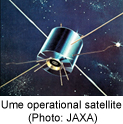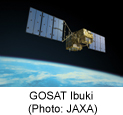
Sharp Corporation has achieved the world’s highest solar cell conversion efficiency*1 of 36.9%*2 using a triple-junction compound solar cell in which the solar cell has a stacked three-layer structure.
Compound solar cells utilize photo-absorption layers made from compounds consisting of two or more elements, such as indium and gallium. Because of their high conversion efficiency, compound solar cells have been used primarily on space satellites.
Since 2000, Sharp has been pursuing research and development of a triple-junction compound solar cell that achieves high conversion efficiency by stacking three photo-absorption layers. In 2009, Sharp succeeded in improving cell conversion efficiency to 35.8% based on proprietary technology that enabled efficient fabrication of a stacked triple-layer structure with InGaAs (indium gallium arsenide) as the bottom layer.
This latest increase in conversion efficiency was achieved by improving the maximum power output of the solar cell by reducing the resistance of the junction areas necessary to connect the solar cell layers in series.
Sharp achieved this latest breakthrough as a result of a research and development initiative promoted by Japan’s New Energy and Industrial Technology Development Organization (NEDO)*3 on the theme of “R&D on Innovative Solar Cells.” Measurement of the value of 36.9%, which sets a new record for the world’s highest non-concentrating conversion efficiency, was confirmed at the National Institute of Advanced Industrial Science and Technology (AIST).
In the future, processes for transferring ultra-thin photovoltaic layers onto film substrates will make lightweight, flexible solar cells possible. Sharp’s goal in the years to come is to take full advantage of this latest development success for use in concentrator-type solar cells, as well as for practical applications such as on space satellites and for flight craft and land vehicles.
Structure of Triple-Junction Compound Solar Cell
| *1 |
As of November 4, 2011, for non-concentrator solar cells at the research level (based on Sharp survey). |
| *2 |
Conversion efficiency confirmed by the National Institute of Advanced Industrial Science and Technology (AIST; one of the organizations around the world that officially certifies energy conversion efficiency measurements in solar cells) in September 2011. (Cell surface: approx. 1 cm2) |
| *3 |
The New Energy and Industrial Technology Development Organization (NEDO) is Japan’s public management organization for promoting rese arch and development as well as for disseminat ing industrial, energy, and environmental technologies. |
Wavelength Distribution of Solar Photo-Energy and Wavelength Sensitivity of Triple-Junction Compound Solar Cell
History of Sharp Compound Solar Cell Development
| 1967 |
|
Development begins of solar cells for space applications using single-crystal silicon. |
| 1976 |
|
Launch of operational Japanese satellite, “Ume,” equipped with Sharp solar cells for space applications (single-crystal silicon solar cell). |
 |
| 2000 |
|
Research and development begin on triple-junction compound solar cell to further improve efficiency, reduce weight, and increase durability of solar cells for space applications. |
| 2001 |
|
Participation in research and development on NEDO’s photovoltaic power generation themes . |
| 2002 |
|
Triple-junction compound solar cell gains certification from the Japan Aerospace Exploration Agency (JAXA). |
| 2003 |
|
Conversion efficiency of 31.5% is achieved (at the research level) for triple-junction compound solar cell . |
| 2005 |
|
Launch of small scientific satellite, “Reimei,” equipped with Sharp triple-junction compound solar cells. |
| 2007 |
|
Conversion efficiency of 40.0% achieved (at the research level) for a triple-junction compound solar cell (concentrator type , at 1,100 times concentrated sunlight). |
| 2009 |
|
Launch of Greenhouse gases Observing SATellite (GOSAT), “Ibuki”, equipped with Sharp triple-junction compound solar cells. |
 |
| 2009 |
|
Conversion efficiency of 35.8% is achieved (at the research level) for a triple-junction compound solar cell based on research and development efforts that are part of NEDO’s “R&D on Innovative Solar Cells” program. |
| 2011 |
|
Conversion efficiency of 36.9% is achieved (at the research level) for a triple-junction compound solar cell based on research and development efforts that are part of NEDO’s “R&D on Innovative Solar Cells” program. |
|
The following information is true and accurate at the time of publication. Manufacture, sale, price and specifications of products may be subject to change.
|
|